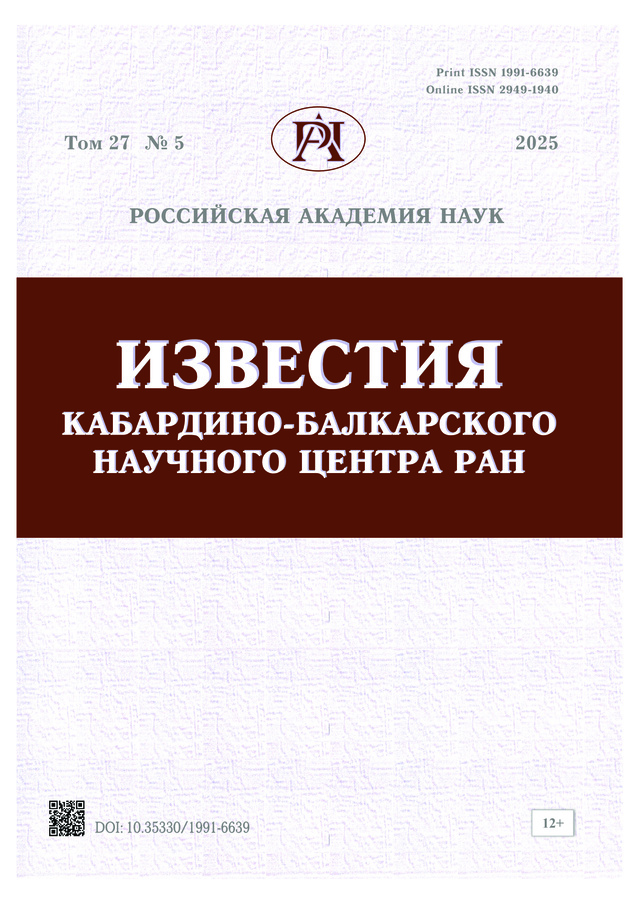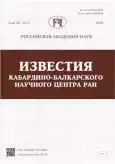Том 26, № 3 (2024)
- Год: 2024
- Выпуск опубликован: 15.06.2024
- Статей: 14
- URL: https://journals.rcsi.science/1991-6639/issue/view/16600
Весь выпуск
Системный анализ, управление и обработка информации
Прогнозирование урожайности зеленых культур на основе мониторинга морфометрических параметров посредством машинного зрения и нейронных сетей
Аннотация
Средства искусственного интеллекта и технического зрения играют важную роль в автоматическом определении стадий роста растений. Исследование направлено на изучение современных технологий для автоматического анализа и измерения характеристик растений, таких как высота, площадь листьев и другие морфометрические параметры. В данной статье рассматривается применение машинного зрения и нейронных сетей для мониторинга морфометрических параметров и прогнозирования урожайности зеленых культур. Разработан алгоритм определения стадий роста салата, который осуществляет сбор данных о растениях с помощью мультиспектральной камеры, а затем анализирует полученную информацию с использованием нейронных сетей. Обучение классификации стадий роста выполнялось на подвыборке исходного датасета, состоящей из 273 случайно отобранных изображений с соблюдением баланса классов (91 изображение в каждом классе). Размер обучающей выборки для каждого класса – 45 изображений и размер тестовой выборки – 46 изображений для каждого класса. Классификация стадий роста показала высокие результаты: более 95 % верно распознанных экземпляров; более 93 % верных распознаваний отдельных стадий роста. По отдельным метрикам (Precision, Recall, F1-score) лучше всего себя показала архитектура ResNet34.
 11-20
11-20


Разработка сервиса коротких мультиязычных переводов на основе распределенной системы обработки аннотированной информации
Аннотация
Разработка сервиса коротких двуязычных переводов представляет собой актуальную задачу создания систем автоматического перевода текстов для средних и малых языков, для которых не существуют аннотированные базы данных, необходимые для обучения. В рамках данной работы реализуется система для автоматического перевода коротких текстов с одного языка на другой, особенностью которой является использование распределенной архитектуры для сбора, обработки, хранения и использования информации, предоставляемой пользователями системы на основе оригинальной модели мотивации, что позволяет значительно увеличить скорость создания обучающей выборки и качество обработки переводов.
 21-31
21-31


Автоматизация и управление технологическими процессами и производствами
Автоматическая калибровка лазерно-сканаторной системы с использованием внешней камеры
Аннотация
В технологии селективного лазерного плавления (СЛП) высокоэнергетический лазер послойно приплавляет металлический порошок к платформе построения. Высокая геометрическая точность является критически важной для производства высококачественных деталей. Современные методы калибровки требуют значительных затрат ручного труда, серьезной модификации оборудования или использования дорогостоящего вспомогательного оснащения. В данной статье представлена новая методика калибровки гальванометрических зеркал для технологии СЛП с использованием внешней камеры. Предлагаемый подход позволяет упростить, удешевить и автоматизировать процесс калибровки.
 32-41
32-41


Эффективность подхода «Архитектура как код» в управлении ИТ-архитектурой предприятия
Аннотация
Потребность в архитектуре предприятия увеличивается по мере масштабирования бизнеса, а при текущем интересе к экосистемам является одним из наиболее востребованных вопросов для изучения. В статье осуществлен сравнительно-сопоставительный анализ существующих подходов в управлении архитектурой информационных технологий (ИТ-архитектура) предприятия. В результате исследования был синтезирован ряд проблем, характерных для рассматриваемых подходов, одной из которых является изолированность ИТ-архитектуры от корпоративной. В рамках цели по митигированию обнаруженных рисков автор предлагает использовать инновационный подход «Architecture as a Code», который лишен выявленных уязвимостей. В статье особое внимание уделяется исследованию возможностей данного принципа и тому, каким образом он делает процесс управления ИТ-архитектурой эффективнее. Автором был разработан набор критериев, однозначно определяющих подход «Архитектура как код». Для этого также было проведено исследование концепции «Diagram as a Code», показавшее фундаментальную разницу понятий. Детально были изучены особенности виртуализации и повторного использования программного кода, являющиеся основополагающими принципами подхода. На основе принципов и критериев автором были сформулированы и классифицированы требования для успешной интеграции нового процесса в организационную структуру предприятия.
 42-54
42-54


Информатика и информационные процессы
Разработка сервиса прогнозирования трудоустройства студентов
Аннотация
В статье представлены архитектура и программная реализация сервиса для сбора данных и прогнозирования трудоустройства студентов на основе полносвязанной нейронной сети на примере выпускников Кабардино-Балкарского государственного университета по направлениям, связанным с информационными технологиями. Сервис реализован в виде веб-сайта и позволяет обеспечить сбор, хранение и анализ данных об успеваемости, активности, трудоустройстве и условиях обучения выпускников. Представленная модель нейронной сети по результатам анкетирования студента прогнозирует основные параметры, связанные с трудоустройством, в том числе ожидаемый уровень оплаты труда, время поиска работы и степень загруженности сотрудника. При этом используемый набор входных параметров позволяет учитывать не только данные об успеваемости, но и демографические показатели, условия в регионе обучения студента. Прогнозирование условий трудоустройства может использоваться не только для выбора направления подготовки абитуриентами и построения образовательных траекторий студентами, но и для планирования изменений в программу обучения вуза. В работе приведены структура сайта, архитектура нейронной сети и описание программной реализации сервиса.
 55-67
55-67


Концепция интеллектуальной системы моделирования экономического развития региона
Аннотация
Исследование посвящено разработке концепции интеллектуальной системы моделирования экономического развития региона, в частности взаимодействию отдельных экономических агентов между собой. Представлены структура интеллектуальной системы моделирования и архитектура мультиагентных моделей экономических агентов. В результате исследования планируется разработать методы и алгоритмы интеллектуальной системы поддержки принятия решений для управления региональным инновационным развитием. Общей целью проекта является создание комплексной системы, способствующей выработке стратегий и реализации мероприятий, направленных на активизацию и эффективное управление инновациями в региональном контексте.
 68-81
68-81


Обзор пищевой аллергии и информационных систем для анализа меню как инструмента контроля пищевых аллергенов
Аннотация
В статье представлен краткий обзор публикационной активности по проблемам пищевой аллергии и информационным системам в сфере организации сбалансированного и безопасного питания на примере пищевой аллергии. Исследование проводилось на материалах, находящихся в базах данных «eLIBRARY», «PubMED», с применением «Bibliometrix» и языка программирования R. Приводятся распределения публикаций, обзор научных достижений в области пищевой аллергии. Используются измерение и сравнение в качестве методов эмпирического исследования. Для более детального технологического анализа меню на пищевые аллергены предлагается методика, основанная на учете зависимости «доза-эффект».
 82-91
82-91


Информационное обеспечение процессов обработки данных устройств интернета вещей в автоматизированной информационной системе экомониторинга
Аннотация
В данной научной статье подробно рассмотрены основные подходы к созданию информационного описания процессов обработки и интеллектуального анализа данных, получаемых с цифровых датчиков, – устройств интернета вещей в автоматизированной информационной системе экологического мониторинга. Приведена краткая классификация методов интеллектуального анализа данных. Дана общая характеристика данных, получаемых с устройств интернета вещей в автоматизированной информационной системе экологического мониторинга. На основе структурного анализа и системного подхода создано формализованное описание процессов обработки данных в информационной системе экологического мониторинга. На основе методологических принципов структурного описания систем проведен анализ информационных потоков в автоматизированной системе экологического мониторинга. Построена обобщенная визуальная информационная модель процесса проведения экологического мониторинга. Выполнена функциональная декомпозиция обобщенной модели, выделены составляющие подпроцессы. На основе методологии функционального моделирования IDEF0 выполнено построение визуальных функциональных моделей процессов обработки и анализа данных в автоматизированной информационной системе экологического мониторинга в виде структурированных диаграмм, необходимых для детализации всех стадий и операций. В ходе проведения декомпозиции выделено пять функциональных блоков. Выполнена разработка информационного обеспечения процессов обработки и анализа данных в автоматизированной информационной системе экологического мониторинга на примере обработки данных, полученных с устройств интернета вещей.
 92-102
92-102


Общее земледелие и растениеводство
Корреляционная связь между хозяйственно полезными признаками у линий сахарной кукурузы
Аннотация
Для создания высокопродуктивных гибридов кукурузы необходимо иметь качественный линейный материал инбредных линий, которые должны обладать рядом хозяйственно полезных признаков, а также быть адаптированными к агроклиматическим условиям. В данной статье представлен результат изучения хозяйственно полезных признаков линий сахарной кукурузы и взаимосвязи этих признаков между собой, а также влияния погодных условий на формирование данных признаков за период с 2020 по 2022 год. Все выбранные линии представлены из имеющегося материала в коллекции ФГБНУ ВНИИ кукурузы, который расположен в Предгорной зоне Ставропольского края – г. Пятигорске. Объектом исследований послужили 10 линий сахарной кукурузы, созданных селекционерами нашего института. В ходе изучения выявлена прямая корреляционная зависимость между такими хозяйственно полезными признаками, как высота растения и высота прикрепления початка (r = 0,92), количество дней до цветения початка и высота растений (r = 0,99), масса 1000 семян и количество рядов (r = 0,78) и др., которые оказываются в прямой взаимосвязи между собой, а также обнаружены хозяйственно полезные признаки, которые не имеют никакой зависимости между вариациями, например: продолжительность периода «всходы – цветение початка» и длина початка (r = –0,68), масса зерна с початка и масса 1000 зерен (r = –0,63), масса зерна с початка и высота растения (r = –0,80) и др. На основе полученных результатов исследования даны рекомендации практической селекции, которые пригодятся для создания гибридов нового поколения.
 103-111
103-111


Региональная и отраслевая экономика
Отечественный и зарубежный опыт агропромышленной интеграции
Аннотация
В статье исследуются вопросы интеграционных процессов, которые затронули фактически все направления аграрного бизнеса. Зарубежный и отечественный опыт подтверждает, что повышения эффективности производства и высокой конкурентоспособности достигают крупные продуктовые компании. Наряду с тем, что они удерживают рынок продукции, еще и имеют возможность мотивировать производителей сырья, используя при этом различные направления интеграции и кооперации. История развития интеграционных процессов как в России, так и за рубежом подтверждает их эффективность за счет объединения всех ресурсов интегрирующихся структур при сохранении юридической самостоятельности. Анализ развития интеграционных процессов в России выявил высокую эффективность и дееспособность интеграции различных форм и типов агропромышленных формирований. Проведенное исследование позволило обосновать необходимость дальнейшего развития и активизации интеграционных процессов в агропромышленном комплексе, позволяющих объединять различные формы и типы хозяйствующих субъектов и формировать мощный потенциал для дальнейшего прорывного развития агропромышленного комплекса страны в условиях цифровой трансформации экономики.
 112-126
112-126


Исторические науки
Отчеты начальника Терской области как источники по изучению вопросов обеспечения населения Нальчикского округа продовольствием в 1889–1905 гг.
Аннотация
В статье рассмотрены всеподданейшие отчеты начальника Терской области в качестве исторических источников по изучению различных аспектов социально-экономической жизни как области, так и входящего в ее состав Нальчикского округа. Проанализированы ежегодные отчеты начальника области с 1889-го по 1905 г. – периода, когда Малая Кабарда не входила в состав Нальчикского округа. Подробно изучены структура и содержание отчетов, а также их динамика. Сделан вывод, что представленная в отчетах начальника области информация позволяет предметно изучить вопросы организации системы обеспечения продовольствием жителей Нальчикского округа.
 127-134
127-134


Традиционные институты регулирования поземельных и некоторых имущественных отношений у балкарского населения Нальчикского округа в последней трети XIX – начале ХХ в.: историографический обзор
Аннотация
В статье предложен историографический обзор функционирования «бегенды» и «ортака» как традиционных институтов регулирования поземельных и некоторых имущественных отношений у балкарского населения Нальчикского округа в последней трети XIX – начале ХХ в. Рассмотрены труды Г. А. Вертепова, Н. П. Тульчинского, М. К. Абаева, Н. М. Рейнке, Е. Н. Студенецкой, Т. Х. Кумыкова, Т. А. Жекомихова, М. Ч. Кучмезовой, Г. К. Азаматова, Е. Г. Муратовой и некоторые обобщающие работы по истории и этнографии народов Кавказа. Установлено, что исследователи при определении дефиниции «бегенда» выделяли такие ее общие характеристики, как: своеобразная форма поземельных отношений, извлечение прибыли от пользования земельным участком в качестве обеспечительной меры по долговым обязательствам (залог), рента взамен частичного или полного погашения процентов, сохранение права собственности за хозяином заложенного имущества, заключение соглашения на неопределенный срок (до погашения долга). Для «ортака» – форма эксплуатации представителей одних социальных групп другими, отождествление с русской испольщиной, получение части прибыли или приплода за пользование чужим земельным участком или скотом и т.п.
 135-141
135-141


Филология
Спортивная терминология современного карачаево-балкарского языка
Аннотация
В статье на материале словарей современного карачаево-балкарского языка впервые исследуется спортивная терминологическая система. В ней выявляются и системно описываются часто употребляемые термины спорта и физической культуры, а также слова (термины), применяемые спортивными судьями. При этом фиксируются проблемы их лексикографирования. В работе обращается внимание на основные источники пополнения и развития спортивной терминосистемы, отмечаются изменения и адаптация терминов. Системно выделяются некоторые спортивные термины иноязычного происхождения. При определении заимствованных и калькированных спортивных лексем были использованы данные разных лексикографических источников. Материалы и выводы данной работы будут способствовать упорядочению и стандартизации спортивных терминов, окажут помощь представителям СМИ в подготовке информации по спортивной тематике. Также они могут быть использованы в процессе создания переводных двуязычных словарей и станут основой для составления словника и переводного словаря спортивных терминов карачаево-балкарского языка, в издании которого давно нуждаются работники масс-медиа.
 142-149
142-149


Юбиляры
Хасану Шамсадиновичу Тарчокову – 85 лет
 150-151
150-151









